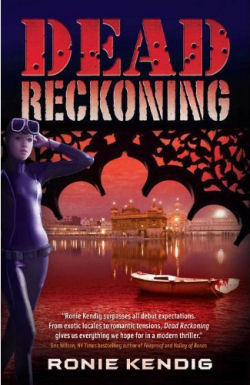|
Wuss.
Chicken. Coward. Yellow-bellied . . .
Well, you get the idea. I’m an
eternal peacemaker who will walk a mile around conflict to avoid it if
I can. I’ll do anything (okay, that’s a smidge exaggerated) so people
will like me or to help someone. Case in point: fourth grade. Cafeteria
lady is collecting milk cartons for some points system thing going on
at the time. So there’s this little girl who sees cartons on the
twenty-foot row of tables she’s assigned to that the cafeteria lady
can’t take because there’s still milk in them. Being the good,
peacemaking, wanna-help-everyone girl that she is, she snatches up
several and gulps down the last of the contents.
Did you gag reading that? Yeah,
me too. Never crossed my mind what could be in there.
So how does a person like me,
who avoids conflict and wears her peacemaker badge prominently and
without shame, write a fast-paced, high-action thriller? Maybe it’s my
“other” self . . . maybe it’s me living vicariously through fake
people. Okay, that sounds like I need therapy.
Let’s move on and peek at some
very common aspects to writing thrillers and action:
Spa Treatment
Pampering characters is a
sure-fire way to kill the tension in your book. In just about every
self-help book I’ve read, the common key is high stakes.
Are you going easy on your characters? Then stop—and throw everything
at them. Is your character a sniper in the middle of an integral
mission? Then blind him. No, I’m not kidding—and I just did that to one
of my characters in Digitalis (January 2011,
Barbour).
We humans do not learn or reach
our potential when we are pampered and allowed to skip through life
without experiencing pain. I don’t know about you, but I’ve been
through the gamut of painful experiences. Life wasn’t easy on me, so
why should I be easy on my characters? Seriously, you do yourself a
disservice when you protect your characters.
If your character doesn’t need
therapy—or a serious dose of God—by the dénouement, then maybe you
haven’t hit them hard enough. There should be tension/conflict on every
page!
Don’t Interrupt
You’ve painted that high-action
scene, you have bullets flying, motorcycles eating up the cement . . .
and the author comes on with Public Service Announcement about a
painful point in the hero’s past.
Um, that’s worse than the guy
sitting next to you in the theater using his iPhone, whose glaring
white display practically blinds you.
Don’t get me wrong. Those points
need to be made, but inserting them in the middle of an intense,
life-or-death scene kills the impact.
Cry, Baby, Cry
Make the reader sigh. We’re in
an adrenaline-exploding scene and suddenly the character stops to
ruminate about her love life. It wasn’t until I took a physiology class
and understood the fight-or-flight reactions in the body that I
realized how unrealistic this. In a life-or-death situation, the
character is going to be focused on one thing: surviving. It’s the
human condition.
Let the adrenaline crash and the
character tank after the immediate threat is over—or at least, when the
character thinks the threat is over.
Domestic
Abuse
Okay, step off the ledge. I’m
not talking about wife beaters. I’m talking about the abuse of domestic
scenes in a novel. I read
|
years
ago (forgive
me, I can’t remember the
author or book) that an easy crutch for many authors is to set scenes
in the kitchen. Something in me sparked and I vowed right then to avoid
kitchen scenes.
In
writing Digitalis,
my skin began to crawl when I realized there were several domestic
scenes, so I sent Cowboy off on a mission. I get hives when characters
spend too much time in the home.
Bullet-time!
You know what I’m talking about:
The Matrix. In this hit movie, the Wachowski brothers introduced their
amazing technique called Bullet-time, where the speed/trajectory of a
bullet is slowed until the audience can see the disruption of the air
around the bullet as it proceeds toward its target.
So . . . what does this mean for
writers? Pacing. If your stories have the same pacing, you’ll lose your
reader; they’ll get bored. So, when do you slow it down and create that
bullet-time effect? Often for the point in the story that will
irrevocably alter the life of a character(s), aka: the black moment. In
Dead Reckoning, I
slowed down the story during an attack when the paths of the hero and
heroine come together in an explosive collision—this scene is one of
the black moments for Shiloh.
But just like in The
Matrix, know when to speed things back up. Dragging out the
story by giving a blow-by-blow in a scene that has no point other than
blood, guts, and gore is not a good use of words or time for you or
your audience.
6.) Dig ’Er Deeper
You slammed your character with
a cheating girlfriend. So? Do you
really think that’s enough for the hero to want to abandon God and
life? No, it’s not. Unless . . . unless you can pile on the crud. Maybe
the hero’s mother cheated on his father . . . and that’s what led to
his father’s killing her . . . and maybe your hero has an anger
problem. Now he’s afraid he’ll do something bad. Real bad. Oh, and I
did mention he’s a minister? Or a cop?
See? Go deeper. Make it worse.
High stakes. Remember?
Writing a thriller should be a
thrill—a fully engaged adrenaline system. Grab the reader by the throat
and DO NOT LET GO! Remember, tension on every page. High stakes—make it
worse, dig deeper!


|










